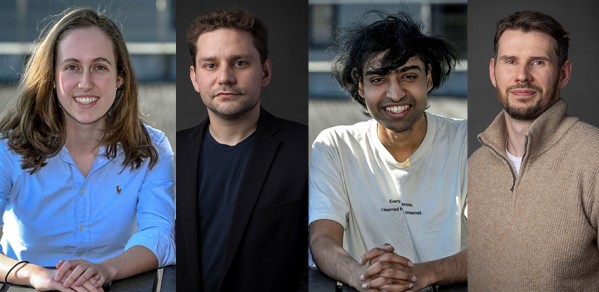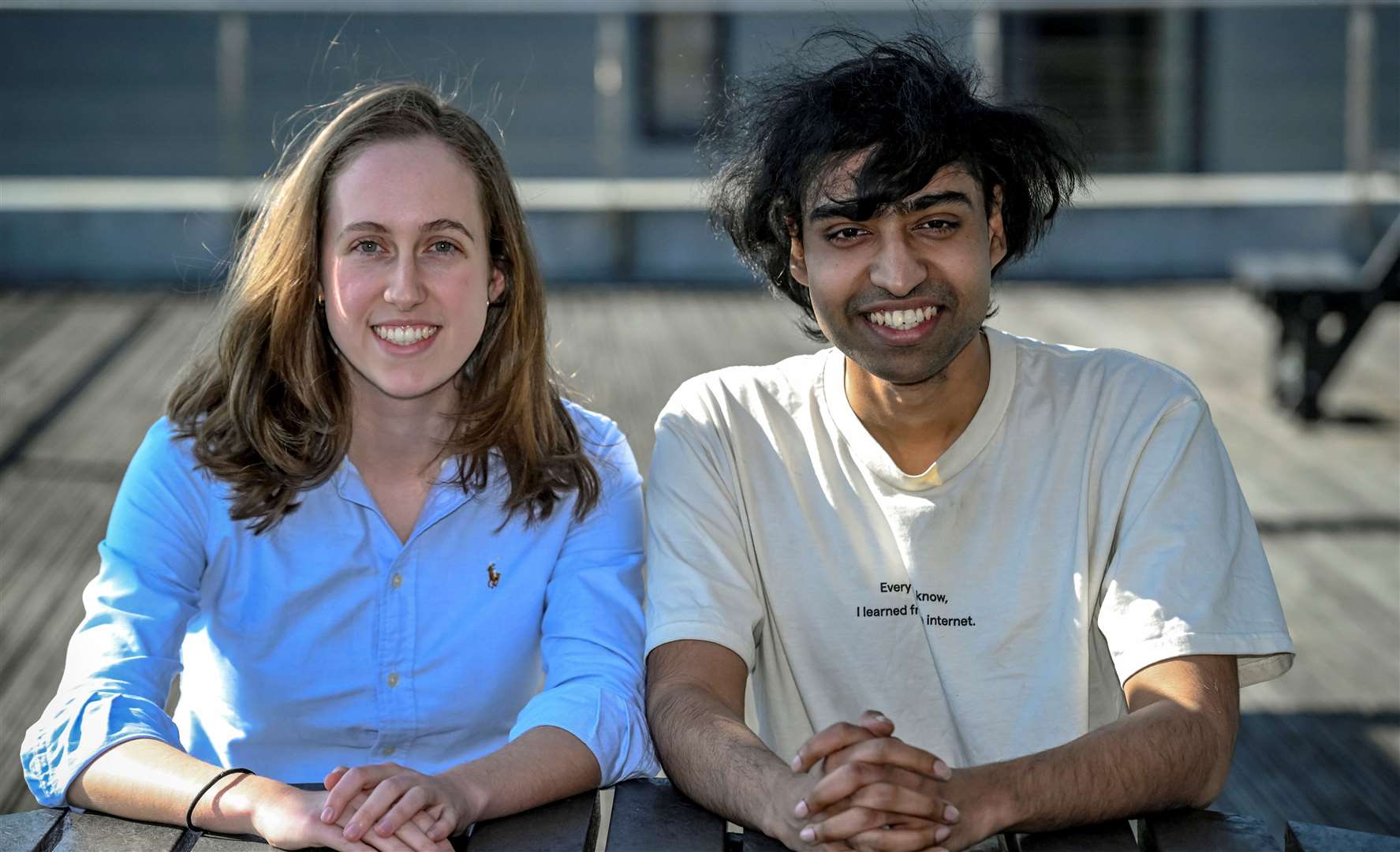
Four alumni whose start-ups are applying University research and technology to solve some of the world’s greatest challenges have graduated from Founders at Cambridge – the flagship initiative supporting and empowering innovators to make an ever greater impact.
The second START Accelerator – a pre-seed accelerator designed to boost the journey of existing ventures – has welcomed Pinepeak (co-founded by Dr Savvas Gkantonas and Dr Daniel Fredrich) and Sqwish (co-founded by Dr Ushnish Sengupta and Federica Freddi).
Over the course of the programme, which ended recently, they honed their research and ideas; engaged with expert mentors, customers and entrepreneurs/operators-in-residence; and took critical steps towards becoming investment-ready.
This strategic initiative is delivered by the University’s innovation arm, Cambridge Enterprise, to connect innovators with a wealth of expertise in venture building, investment and commercialisation. This is complemented by access to a growing global expert community of more than 250 investors, industry executives, entrepreneurs and leaders, many of whom are University alumni.
Introducing Pinepeak – predicting wildfire risk and behaviour using physics-driven technology
Pinepeak was born out of a deeply personal experience. After witnessing firsthand, the devastation caused by the 2018 wildfire in Mati, Greece, co-founder and CEO Dr Gkantonas and his former PhD supervisor Professor Epaminondas Mastorakos asked themselves: “Why were some homes destroyed while others nearby remained virtually untouched? And why are there no tools available to accurately predict this?”
These questions sparked their mission to rethink wildfire modelling from first principles. Their journey began with academic research at Cambridge, leveraging their backgrounds in combustion science and AI to build a novel solution.
Dr Gkantonas was a Senior Research Associate at the Department of Engineering, where his work focused on turbulent reacting flows, thermofluids, and pressing issues in energy, human health and the environment.
Dr Fredrich, co-founder and COO, previously conducted research in fluid dynamics at Cambridge, and he has worked with world-renowned engineering companies across the aerospace, automotive and energy sectors.
Pinepeak develops physics-driven technology to predict wildfire risk and behaviour across any terrain, anywhere in the world.
“Our technology uses ‘virtual particles’ to mimic how fire moves across landscapes through convection, radiation and airborne embers known as firebrands,” says Dr Gkantonas.
“These particles dynamically respond to wind, terrain and types of fuel on the ground (such as trees, dry grass, or flammable building materials).”
Pinepeak gathers environmental data from sources like satellite imagery and processes it using machine learning. The data is then fed into its FLAMESIGHT simulator, which integrates the core physical equations describing fire behaviour.
“Because the simulator is designed for accuracy and speed, we can model thousands of potential wildfire paths in just minutes,” says Dr Fredrich.
“Our predictions are delivered at ultra-high resolution, providing critical insights that help firefighters, re/insurers and communities prepare for what might happen before it happens.”

The four co-founders of Pinepeak and their strategic adviser. Pictured, from left, Richard Green (strategic adviser), Dr Andrea Giusti, Dr Daniel Fredrich, Dr Savvas Gkantonas and Professor Epaminondas Mastorakos.
Learnings from Cambridge
“Pinepeak would not exist without our Cambridge engineering foundation,” said Dr Gkantonas.
“Our core modelling approach is rooted in combustion science research developed at Cambridge – specifically, how flames behave in chaotic environments like jet engines.
“Understanding the physics of turbulent combustion gave us a rigorous way to think about wildfire behaviour, which is similarly complex and dynamic.”
Dr Gkantonas adds: “The freedom to pursue fundamental questions without needing to immediately justify their practical use was essential. At Cambridge, we could explore deep scientific problems, cross disciplinary boundaries, and build on insights from one field to solve challenges in another.
“Pinepeak grew directly out of that mindset, where foundational research and practical application feed into each other. In many other environments, this kind of leap might not have been possible.”
Pinepeak’s key milestones to date
- November 2023: Founded by Dr Gkantonas, Dr Fredrich and fellow former Cambridge researcher Dr Andrea Giusti, together with Professor Mastorakos FREng.
- July 2024: Accepted on the impulse programme for tech innovators.
- December 2024: Raised a £310k (Advance Subscription Agreement) investment round led by Genesis Ventures with Angel co-investment.
- February 2025: Selected for the Founders at the University of Cambridge START 2.0 Accelerator Programme as one of eight cohort companies.
- March 2025: Accepted into the Google for Startups Cloud Program providing $350k in computing credits.
- May 2025: Qualified for the finals of the $11m XPRIZE Wildfire competition alongside partners in the UK, Italy and Australia.
- May 2025: Grew the Pinepeak team to four full-time employees.
Looking to the future
“We are excited to connect with other mission-driven founders through the START 2.0 Accelerator, refine our go-to-market strategy, and supercharge our growth from technology prototype to paying customers,” says Dr Fredrich.
“Our ultimate goal is to become the global standard in wildfire intelligence: protecting lives, ecosystems, and economies from climate-driven disasters,” adds Dr Gkantonas.
“We want every re/insurer, emergency responder, utility, land developer, and policymaker to have access to real-time, predictive wildfire insights that empower smarter, safer decision-making. More broadly, we aim to build climate resilience through science-backed technology that bridges the gap between global risk and local action.”
Introducing Sqwish – the ‘brain’ that sits between AI apps and model providers
Sqwish was born out of frustrations experienced while building an AI-powered creative thinker (Ideom AI). Co-founders Dr Ushnish Sengupta and Federica Freddi hit scaling walls: a mixture of rising costs, unpredictable latency and inconsistent performance. This led to them building Sqwish – a smart, real-time performance layer that dynamically optimises performance, speed, cost and reliability at scale: without the headache.
“Sqwish is the brain between your app and the big AI models,” says Dr Sengupta, who has a PhD from Cambridge, applying AI to high-stakes engineering problems. “It is a smart, real-time performance layer that squeezes every drop of speed, quality and efficiency from AI inference.”
Federica holds a Master of Engineering (MEng) in Information Engineering from Cambridge and developed her expertise in deep model pruning, retrieval-augmented generation and meta-learning.
She adds: “Sqwish rewrites long messy inputs on the fly, chooses the best models and hardware for the task, combines their strengths and weaknesses, reuses existing data smartly and learns what works best over time.
“Instead of betting on one model AI provider, we combine the best of them and squeeze out more performance than any one provider can alone with our tiny AI models. That means smarter, faster, cheaper AI – without the software developer needing to lift a finger.”
Learnings from Cambridge
While Federica has previous experience working on vision systems for robots gained during her MEng, Dr Sengupta applied AI to rocket instabilities during his PhD.
“We have carried over that obsession with edge-case performance, real-time systems and making high-stakes tech reliable under pressure,” he says. “Sqwish is basically that mindset, just applied to AI infrastructure.”
Key milestones to date
- Minimum viable product (MVP) launched
- 13 design partners
- Growing the team to four people
- Opening Sqwish’s pre-seed round of $1.5 million.
Looking to the future
“We have enjoyed connecting with other ambitious founders and building the early Cambridge network that will stay with us for the long haul, as well as practicing the art of storytelling,” says Federica.
“We are building the performance layer for the next generation of AI software. As billions of AI agents interact trillions of times per day, someone needs to make that run smarter, faster, cheaper and reliably. Sqwish wants to be the invisible engine behind it all. And if we can make AI more sustainable, by shrinking compute and energy usage, that is a win for the planet, too.”
Dr Diarmuid O’Brien, Pro-Vice-Chancellor for Innovation, University of Cambridge, said: “The new START 2.0 cohort are a clear example of the need to take the world-changing research taking place every day at Cambridge out into the world.
“Founders was created to bridge the gap between the lab and commercial businesses and I’m excited to see what this new cohort achieves.”
Adapted from a Founders at the University of Cambridge article.


